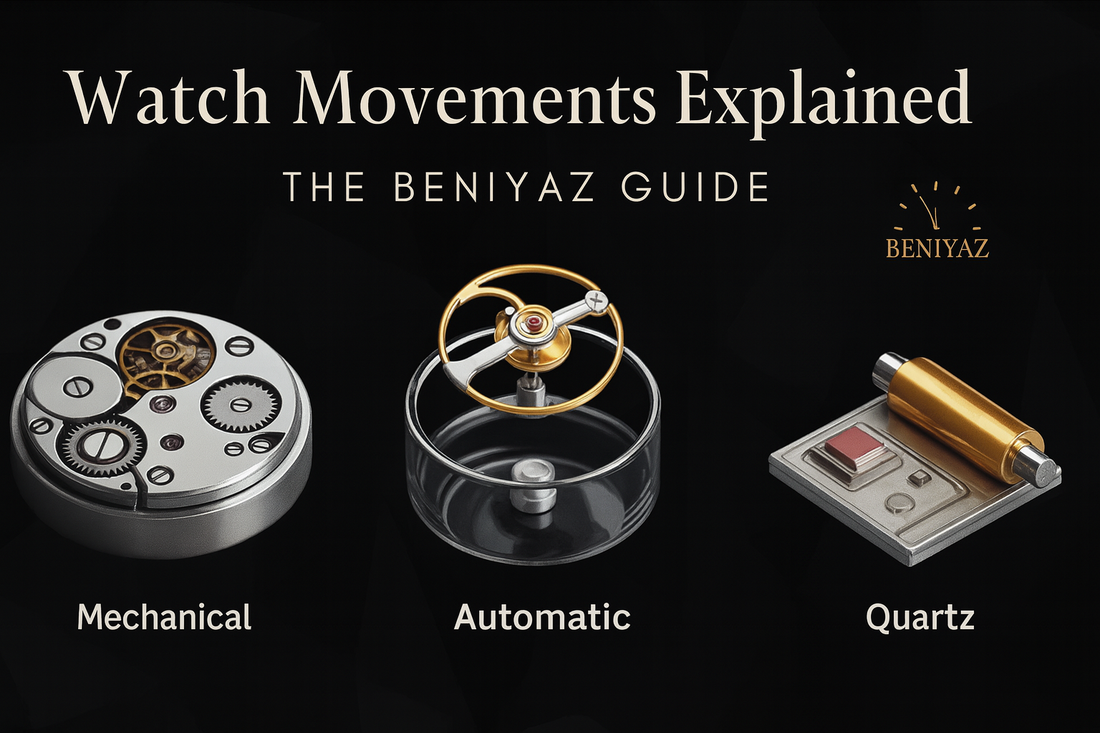Have you ever looked at your wrist and wondered what makes your watch tick? Behind every smooth sweep or steady tick of a second hand lies the true heart of a watch – the movement. It’s the invisible engine that powers the hours, minutes, seconds, date, and every special function your timepiece may have.
At Beniyaz, we believe understanding watch movements helps you choose a timepiece that matches your style, needs, and budget. Whether it’s the tradition of mechanical craftsmanship, the convenience of automatic self-winding, or the precision of quartz technology, every movement has its own character and story.
What Is a Watch Movement?
A movement (also called a caliber) is the watch’s engine. It keeps time, drives the hands, and powers additional features like date displays or chronographs. All movements fall into three main categories:
1. Mechanical (Manual Wind)
2. Automatic (Self-Winding Mechanical)
3. Quartz (Battery Powered)
1. Mechanical Movement (Manual Wind)

The mechanical movement is the oldest and most traditional watch mechanism, requiring no battery. Instead, it stores energy in a mainspring, which is wound manually using the crown. As the spring unwinds, gears and an escapement regulate the release of energy to keep time.
Why Choose Mechanical
· Celebrated for traditional watchmaking heritage
· Can last for generations with proper care
· Appeals to collectors and enthusiasts
Things to Consider
· Needs regular winding (often daily)
· Slightly less accurate than quartz
· Sensitive to shock and magnetic fields
2. Automatic Movement (Self-Winding)

An automatic movement is also mechanical, but winds itself using a rotor that moves with your wrist’s motion. This motion tightens the mainspring, powering the watch without daily manual winding.
Why Choose Automatic
· Combines traditional craftsmanship with everyday convenience
· No battery required
· Long service life when serviced every 3–5 years
Things to Consider
· Should be worn regularly or stored in a watch winder
· Often more expensive than quartz
Slightly thicker case size due to rotor mechanism
3. Quartz Movement (Battery Powered)

Quartz watches run on a battery that sends an electrical current through a quartz crystal, causing it to vibrate at a consistent frequency. These vibrations are converted into precise movements of the hands.
Why Choose Quartz
· Exceptional accuracy
· Low maintenance and affordable
· Slim case designs possible
Things to Consider
· Requires battery replacement every 1–2 years
· Less collectible than mechanical or automatic watches
· Lacks the intricate mechanical feel
4. Japanese vs Swiss Movements

Japanese Movements
Japanese movements are known for accuracy, durability, and affordability. Produced with efficient mass-manufacturing techniques, they offer excellent performance for both quartz and automatic types.
Advantages
· Reliable and cost-effective
· Available in a wide range of styles and price points
· Innovative technology like solar power and hybrid systems
Swiss Movements
Swiss movements are globally recognized for luxury, craftsmanship, and heritage. Often hand-assembled, these calibers undergo strict quality checks and frequently meet chronometer-grade accuracy standards.
Advantages
· Exceptional craftsmanship and prestige
· Strong resale value
· Designed for multi-generation longevity
|
Feature |
Mechanical |
Automatic |
Quartz |
|
Power Source |
Hand-wound |
Self-winding |
Battery |
|
Accuracy |
Moderate |
Good |
Excellent |
|
Maintenance |
High |
Medium |
Low |
|
Price Range |
Medium–High |
Medium–High |
Low–Medium |
|
Lifespan |
Very Long |
Long |
Moderate |
|
Appeal |
Traditional |
Modern Heritage |
Practical Everyday |
How to Choose the Right Movement – Beniyaz Tips
1. Set Your Budget
o Quartz: Most affordable and low-maintenance
o Automatic/Mechanical: Higher investment but more craftsmanship
2. Consider Usage
o Daily Wear / No-Fuss: Quartz
o Style with Function: Automatic
o Heritage Appeal: Mechanical
3. Think About Style
o Classic Look: Mechanical
o Luxury Modern: Automatic
o Minimalist Practical: Quartz
4. Plan for Collectability
o Mechanical and Swiss-made automatics often hold or increase value
o Quartz is functional but rarely collectible
Beniyaz’s Perspective
At Beniyaz, we celebrate all watch movements because each has its purpose:
· Mechanical for timeless tradition
· Automatic for a blend of heritage and convenience
· Quartz for accuracy and ease
Your perfect watch isn’t just about telling time—it’s about matching your lifestyle, expressing your personality, and enjoying the craftsmanship on your wrist.
Final Thought
Behind every Beniyaz watch is a movement built to perform, endure, and inspire. Whether you choose mechanical, automatic, or quartz, remember—it’s the movement that brings your timepiece to life.

